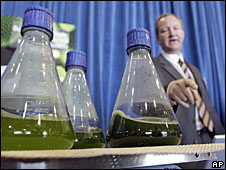First flight of algae-fuelled
jet
Jan 8, 2008 - BBC Monitor
 |
| The biofuel's developers showcased
its algal origins |
A US airline has completed the first test flight
of a plane partly powered by biofuel derived from
algae.
The 90-minute flight by a Continental Boeing 737-800
went better than expected, a spokesperson said.
One of its engines was powered by a 50-50 blend
of biofuel and normal aircraft fuel.
Wednesday's test is the latest in a series of demonstration
flights by the aviation industry, which hopes to
be using biofuels within five years.
The flight was the first by a US carrier to use
an alternative fuel source, and the first in the
world to use a twin-engine commercial aircraft (rather
than a four-engine plane) to test a biofuel blend.
The flight from Houston's Bush Intercontinental
Airport completed a circuit over the Gulf of Mexico,
and pilots carried out a series of tests at 38,000ft
(11.6km), including a mid-flight engine shutdown.
"The airplane performed perfectly," test pilot
Rich Jankowski told the Houston Chronicle newspaper.
"There were no problems. It was textbook."
'Drop-in fuel'
Continental Airlines chief executive Larry Kellner
described the biofuel as a "drop-in fuel", which
meant that no modification to the aircraft or its
engines was required.
The fuel is also understood to meet and exceed
specifications necessary for jet fuel, including
a flash point and a freezing point appropriate for
use in aircraft.
"The challenge will be to produce it in an efficient
way in the quantities we need," Mr Kellner said.
The biofuel used in the demonstration flight was
a blend of two different types of alternative oils
- algae and jatropha.
Jatropha is a plant that can grow successfully
in poor soils and marginal land, yet it yields four
times more fuel per hectare than soybean.
However, algae is viewed by many as a key fuel
for the future because it is fast growing, does
not compete with food crops for arable land, and
yields up to 30 times more fuel than standard energy
crops.
But despite advances in the technology, biofuels
derived from algae have yet to be proven as commercially
competitive.
Clear sky thinking
Despite airlines continually improving the fuel
efficiency of their aircraft over the past three
decades, a growing number of aircraft making more
flights has seen the sector's global emissions rise
sharply.
As a result, the aviation industry is keen to embrace
the environmental benefits that biofuels can offer.
In February 2008, a Virgin 747 flew from London
to Amsterdam partly using a fuel derived from a
blend of Brazilian babassu nuts and coconuts.
And at the end of December, one engine of a Air
New Zealand 747 was powered by a 50/50 blend of
jatropha plant oil and standard A1 jet fuel.



